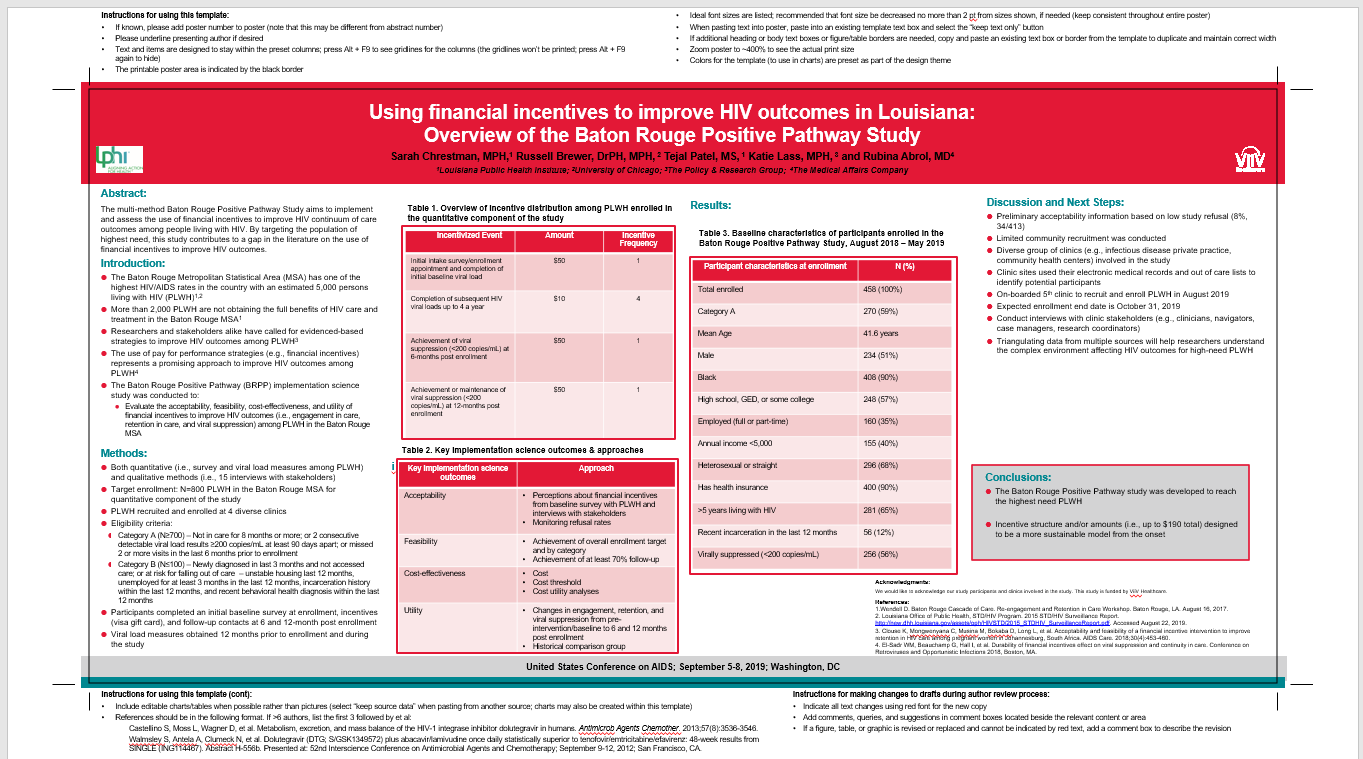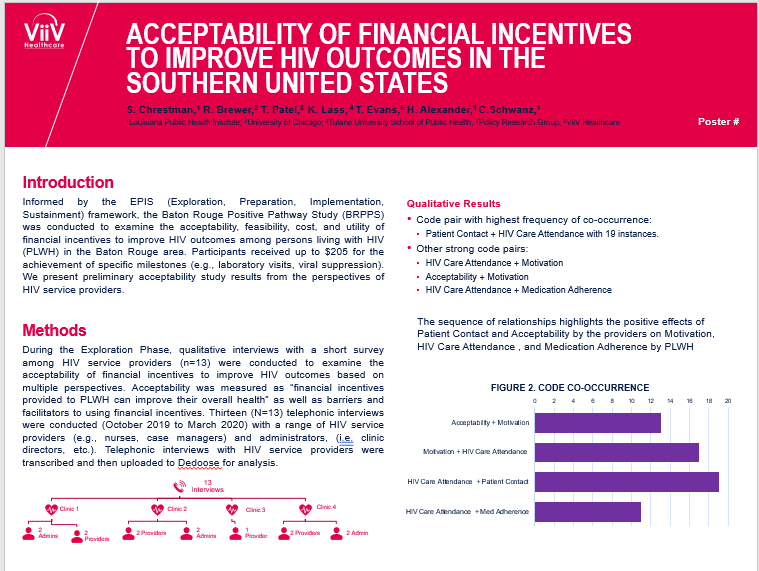BATON ROUGE POSITIVE PATHWAY RESEARCH STUDY – ENGAGING AND RETAINING PERSONS LIVING WITH HIV (PLHIV) IN CARE USING FINANCIAL INCENTIVES
Background
In order to reach the 95-95-95 targets for 2025, additional evidenced-based strategies are needed to re-engage PLHIV currently outside the health care clinic. Financial incentives used to engage and retain PLHIV with the goal of contributing to viral suppression represents a promising approach for exploration in the Baton Rouge, LA area. Compared to the future costs of caring for PLHIV who are not engaged and/or viral suppressed, financial incentives may be cost-effective and valuable in retaining PLHIV in care.
Design
This study consists of a longitudinal cohort of 800 PLHIV who are followed at 6 and 12-months post enrolment. The design includes quantitative (i.e., survey and viral load measures among PLHIV) and qualitative methods (i.e., 15 interviews with stakeholders). received incentives (visa gift card), and follow-up contacts at 6 and 12-months post enrolment. Viral load measures were obtained 12 months prior to enrolment and during the study.
Primary objectives
- Evaluate the feasibility and acceptability of financial incentives among PLHIV and HIV service providers in Baton Rouge, LA
- Examine the impact and cost-effectiveness of using financial incentives to support engagement, retention, and ultimately viral suppression among PLHIV in the Baton Rouge MSA
Results
- Financial incentives were measured on a five point Likert scale. Strongly Agree and Agree were combined as well as Strongly Disagree and Disagree.
- 70% of providers believe financial incentives can improve overall health of PLHIV
- 80% of providers believe financial incentives can improve the viral load of PLHIV
- 90% of providers believe financial incentives can improve HIV care visit attendance of PLHIV
Table 3. Baseline characteristics of participants enrolled in the Baton Rouge Positive Pathway Study, August 2018 – May 2019
Participant characteristics at enrolment |
N (%) |
||
|---|---|---|---|
Participant characteristics at enrolment | Total enrolled | N (%) | 458 (100%) |
Participant characteristics at enrolment | Category A | N (%) | 270 (59%) |
Participant characteristics at enrolment | Mean Age | N (%) | 41.6 years |
Participant characteristics at enrolment | Male | N (%) | 234 (51%) |
Participant characteristics at enrolment | Black | N (%) | 408 (90%) |
Participant characteristics at enrolment | High school, GED, or some college | N (%) | 248 (57%) |
Participant characteristics at enrolment | Employed (full or part-time) | N (%) | 160 (35%) |
Participant characteristics at enrolment | Annual income <5,000 | N (%) | 155 (40%) |
Participant characteristics at enrolment | Heterosexual or straight | N (%) | 296 (68%) |
Participant characteristics at enrolment | Has health insurance | N (%) | 400 (90%) |
Participant characteristics at enrolment | >5 years living with HIV | N (%) | 281 (65%) |
Participant characteristics at enrolment | Recent incarceration in the last 12 months | N (%) | 56 (12%) |
Participant characteristics at enrolment | Virally suppressed (<200 copies/mL) | N (%) | 256 (56%) |
Collaborators
Louisiana Public Health Institute
Setting
Five diverse clinics
Location
U.S.A.
Duration
Aug 2018 - Feb 2021
Category
Retention in Care and Adherence
Key study materials
RELATED STUDIES
As part of an effort to re-engage patients into care, this study determined the effectiveness of using an outreach nurse as a direct clinical liaison through the State Bridge Counsellor (SBC) Program.
To aid future research on the effectiveness of the U=U message campaign as a clinical intervention, the aim of this project is to evaluate the effectiveness of a clinic-delivered media campaign of the U=U message.
This study demonstrated how the effective implementation of a clinical care monitoring system increased the number of patients engaged across the care continuum and improved patient outcomes.
Study focus areas
Our implementation research projects have a global reach and focus on improving the HIV prevention and care continuum.

NP-GBL-HVX-WCNT-220049 October 2023
Adverse events should be reported. Reporting forms and information can be found at yellowcard.mhra.gov.uk or search for MHRA Yellowcard in the Google Play or Apple App store. Adverse events should also be reported to GlaxoSmithKline on 0800 221441.
If you are from outside the UK, you can report adverse events to GSK/ViiV by selecting your region and market, here.


